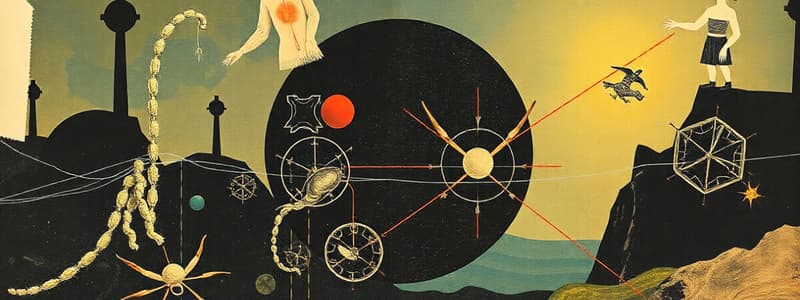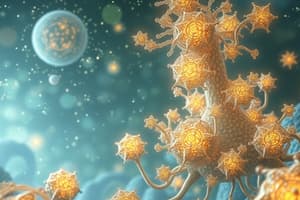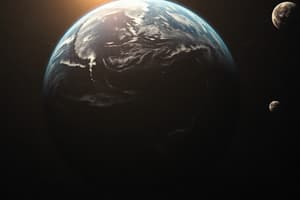Podcast
Questions and Answers
Who was the first to contest the theory of abiogenesis?
Who was the first to contest the theory of abiogenesis?
- Lazaro Spallanzani
- Aristotle
- Francesco Redi (correct)
- Louis Pasteur
What was Lazaro Spallanzani's significant contribution to the understanding of the origin of life?
What was Lazaro Spallanzani's significant contribution to the understanding of the origin of life?
- Proposition that microbes originated from pre-existing microbes (correct)
- Advocating for the theory of evolution
- Disproving abiogenesis
- Development of the Swan Neck Flask
Which scientist is known as the 'Father of Microbiology'?
Which scientist is known as the 'Father of Microbiology'?
- Pierre Louis Moreau de Maupertuis
- Lazaro Spallanzani
- Louis Pasteur (correct)
- Francesco Redi
Which theory proposes that life originated from the combination of moisture and the sun?
Which theory proposes that life originated from the combination of moisture and the sun?
What did Aristotle propose regarding the origin of life?
What did Aristotle propose regarding the origin of life?
Which experiment involved using a Swan Neck Flask to demonstrate the necessity of oxygen?
Which experiment involved using a Swan Neck Flask to demonstrate the necessity of oxygen?
Which philosopher proposed that different animal parts combined together resulted in life?
Which philosopher proposed that different animal parts combined together resulted in life?
What theory did Pierre Louis Moreau de Maupertuis contribute to the understanding of species?
What theory did Pierre Louis Moreau de Maupertuis contribute to the understanding of species?
What significant event occurred 65 million years ago?
What significant event occurred 65 million years ago?
Which region is NOT part of the biogeographic regions mentioned?
Which region is NOT part of the biogeographic regions mentioned?
What does the Continental Drift Theory explain?
What does the Continental Drift Theory explain?
What contributed to fossilization according to the content?
What contributed to fossilization according to the content?
Which organism serves as an example supporting the Continental Drift Theory?
Which organism serves as an example supporting the Continental Drift Theory?
What is primarily studied in paleontology?
What is primarily studied in paleontology?
What significant geological movement occurred 50 million years ago?
What significant geological movement occurred 50 million years ago?
Which of the following pairs correctly match a region with its location?
Which of the following pairs correctly match a region with its location?
Who is known as the Father of Taxonomy?
Who is known as the Father of Taxonomy?
What concept did Aristotle propose regarding species?
What concept did Aristotle propose regarding species?
Which of the following structures was proposed by Georges-Louis Buffon?
Which of the following structures was proposed by Georges-Louis Buffon?
What idea did Erasmus Darwin contribute to biological thought?
What idea did Erasmus Darwin contribute to biological thought?
Which experiment is associated with Stanley Lloyd Miller and Harold Clayton Urey?
Which experiment is associated with Stanley Lloyd Miller and Harold Clayton Urey?
What does the concept of biogenesis suggest?
What does the concept of biogenesis suggest?
What theory did Jean Baptiste Lamarck propose?
What theory did Jean Baptiste Lamarck propose?
Who proposed the idea of limited resources leading to a struggle for existence?
Who proposed the idea of limited resources leading to a struggle for existence?
What was the name of the supercontinent that existed around 250 MYA?
What was the name of the supercontinent that existed around 250 MYA?
Which type of fossil preserves the actual topography of an organism?
Which type of fossil preserves the actual topography of an organism?
During which geological period did Pangaea completely break up into Laurasia and Gondwanaland?
During which geological period did Pangaea completely break up into Laurasia and Gondwanaland?
What is the correct term for fossils that display the activities of organisms, such as nests or footprints?
What is the correct term for fossils that display the activities of organisms, such as nests or footprints?
What geological feature was at play during the 135 MYA separation of India from Antarctica?
What geological feature was at play during the 135 MYA separation of India from Antarctica?
Which fossilization process results in the replacement of organic components with minerals?
Which fossilization process results in the replacement of organic components with minerals?
What significant event characterized the Hadean Eon?
What significant event characterized the Hadean Eon?
How were the original components of petrified fossils affected during the fossilization process?
How were the original components of petrified fossils affected during the fossilization process?
What significant event is associated with the Carnian Pluvial Event during the Triassic Period?
What significant event is associated with the Carnian Pluvial Event during the Triassic Period?
What key feature distinguished Archaeopteryx from modern birds?
What key feature distinguished Archaeopteryx from modern birds?
During which geological period did the rise of amphibians prominently occur?
During which geological period did the rise of amphibians prominently occur?
What was a major consequence of the KT Extinction event?
What was a major consequence of the KT Extinction event?
How did the introduction of oxygen during the Proterozoic Eon affect the environment?
How did the introduction of oxygen during the Proterozoic Eon affect the environment?
What role did Tiktaalik play in evolutionary history?
What role did Tiktaalik play in evolutionary history?
Which major fish group first appeared during the Devonian Period?
Which major fish group first appeared during the Devonian Period?
What significant evolutionary development occurred in the transition from reptiles to modern birds?
What significant evolutionary development occurred in the transition from reptiles to modern birds?
Flashcards are hidden until you start studying
Study Notes
Theories on Origin of Life
-
Creationism: Life forms were created by a supreme being.
-
Spontaneous/Anomalous Generation (Abiogenesis): Life originates from non-living matter.
-
Anaximander: Life arose from a combination of moisture and sunlight.
-
Anaximenes: Slime combined with sunlight resulted in life.
-
Thales: All beings originated from water.
-
Empedocles: Life originated from different animal parts combining together.
-
Anaxagoras: Plants originated from air and animals from aether.
-
Aristotle: Popularized the idea of spontaneous generation.
-
Vitruvius: Bookworms originated from books exposed to southern winds.
-
Atheneum: Sea foam produced anchovies.
-
Francesco Redi: First to contest abiogenesis. Conducted experiments with meat broth to disprove the theory.
-
Lazaro Spallanzani: Developed the first meat broth experiment. Proposed microbes originated from pre-existing microbes, but his work was rejected due to the absence of oxygen in his setup.
-
Louis Pasteur: Disproved spontaneous generation with modified experiments using the Swan Neck Flask to account for oxygen.
-
-
Biogenesis: Living matter only arises from other living matter.
-
Life Originated from the Last Universal Common Ancestor (LUCA).
-
Jean Baptiste Lamarck: Proposed that species change due to the Theory of Use and Disuse, where modifications in one generation can be passed down.
-
Stanley Lloyd Miller and Harold Clayton Urey: Proved the Oparin-Haldane Theory by simulating early Earth conditions and discovering amino acids.
-
Thomas Robert Malthus: Proposed that limited resources cause a struggle for existence.
-
-
Cosmozoic/Panspermia: Life originated from outer space and came to Earth.
- Svante Arrhenius: Proposed that life originated from outer space and travelled to Earth.
Macroevolution
- Occurs over millions of years and involves many species and populations.
Biogeography
-
Deals with the distribution of flora and fauna throughout time.
-
Continental Drift Theory: Explains the distribution of fossils and similar species across different continents.
-
Alfred Wegener: Proposed the theory.
-
Timeline:
- 250 MYA: All continents were combined into a single supercontinent called Pangaea.
- 200 - 180 MYA (Triassic Period, Mesozoic Era): Pangaea broke up into Laurasia and Gondwanaland.
- 170 MYA: Madagascar was located between South America and India.
- 162 MYA: Continental plates began to break off.
- 135 MYA: India began to separate from Antarctica, South America, and Africa.
- 125-100 MYA: India completely separated from Antarctica.
- 88 MYA: Madagascar separated from India.
- 80 MYA: New Zealand separated from Antarctica and Australia.
- 65 MYA: K-T Extinction occurred.
- 50 MYA: India collided with Asia.
- 45 - 38 MYA: Africa moved closer to Europe, South America moved below North America, and Australia moved away from Antarctica.
-
-
Biogeographic Regions:
- Palearctic: Europe, Siberia, East Asia, and the Middle East.
- Oriental Region: Southeast and South Asia.
- Ethiopian: Sahara.
- Nearctic: North America.
- Neotropical: South America.
- Australian: Australia, Oceania, and New Guinea.
Paleontology
-
Derived from the Greek words: Palaios (ancient) + on (being) + logos (to study).
-
Fossils:
- Sedimentation: Older layers are located deeper.
- Types:
- Molds: Preserve the topography of organisms.
- Casts: Stony replicas where organic components are replaced with minerals.
- Carbon films: Carbon components of plants and algae are preserved.
- Trace fossils: Show activities of organisms (nests, coprolites, footprints).
- Preserved remains: Actual body is preserved in amber, or are mummified/frozen.
- Petrified: Similar to casts, but original components are hardened by infiltrating media.
-
Neanderthals: Evidence suggests they were capable of abstract thinking.
-
Homo naledi: Burial chambers have been found.
History of Life on Earth
-
Hadean Eon: Earth has a molten surface with volcanic activity and asteroid impacts.
-
Archean Eon: No free oxygen. The primordial soup formed.
-
Proterozoic Eon: Oxygenation events.
-
Phanerozoic Eon: Abundant animal and plant life proliferated and diversified.
-
Paleozoic Era:
- Cambrian Period: Agnathans were abundant.
- Ordovician Period: Agnathans diversified. Plants migrated to land.
- Silurian Period: Land animals (insects) were abundant. Hospitable environment due to oxygenation. Armored fishes (placoderms) were present.
- Devonian Period: Rise of amphibians. Notably, Tiktaalik appeared. Diversification of armored fishes. Chondrichthyes appeared.
- Carboniferous Period: Fossil supplies multiplied due to acidification and the death of fungi.
- Permian Period: Mass extinction event.
-
Mesozoic Era:
- Triassic Period:
- Carnian Pluvial Event: 2 million years of rain.
- Dinosaurs were first observed.
- Small nocturnal scavengers (first mammals) were also observed.
- Jurassic Period:
- Dinosaurs proliferated.
- Rise of birds with tails, teeth, and gliding wings.
- Proto-Aves, Archaeopteryx were observed.
- Cretaceous Period:
- KT Extinction: Dust enveloped the Earth's atmosphere, preventing life activity.
- Mammals prevailed due to their scavenger habit..
- Triassic Period:
-
Cenozoic Era:
- Tertiary Period:
- Proliferation of mammals.
- Evolution of hominids.
- Homo sapiens sapiens and Neanderthals populated Earth.
- Quaternary Period:
- Tertiary Period:
-
Studying That Suits You
Use AI to generate personalized quizzes and flashcards to suit your learning preferences.




